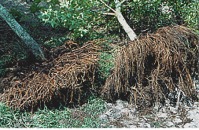Home > Planting trees > Nursery stock selection > Root ball dimensions
Root ball dimensions
Root balls of any shape can be planted in well-drained loamy or sandy soil. However, a relatively tall root ball might help keep deeper roots moist since the deeper soil layers dry more slowly than the soil near the surface.
Shallow root balls may dry quicker on well-drained sites than deeper root balls (Marshall and Gilman 1998). Low-profile (wide but shallow) root balls are probably better suited than traditionally-shaped or standard root balls for planting in poorly-drained and compacted sites. Low-profile root balls are produced in low-profile containers or from field nurseries with compacted subsoil or high water table. See: root ball dimension chart. or American Standard for Nursery stock.
Low profile root balls (third and sixth from left) are well suited for compacted soils and sites with poor drainage. The shape of a low-profile root ball resembles the natural shape of many tree and shrub root systems, i.e. shallow and wide. Roots in the deeper part of a traditionally-shaped root ball could die if they are submerged in water, or placed in a compacted soil with poor aeration. This stress could slow the establishment rate or kill the tree. |
Low profile field root balls come from nurseries with a high water table or compacted soil. |



